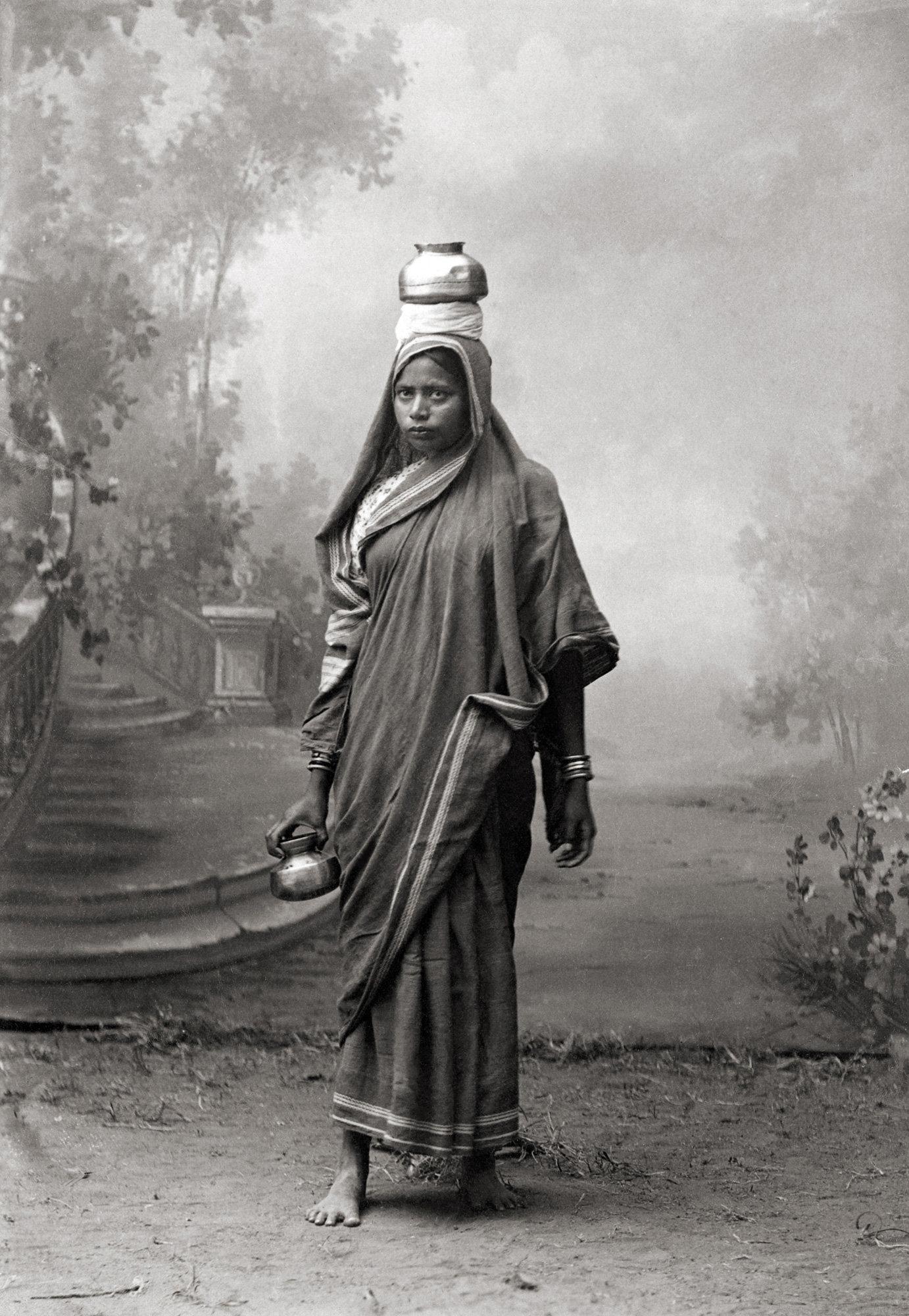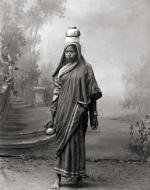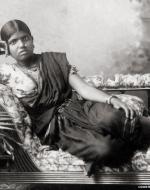Created by Jade Ryerson on Fri, 10/23/2020 - 01:05
Description:
During the Victorian era, womanhood was closely linked with civilization. For this reason, notions of women’s capacity for moral influence carried over into imperialist ideology. With this moralizing force at the core of British society, Britain could rightly claim superiority over other nations. Within the colonial project, the British projected their notions of proper femininity and moral uprightness onto Indian society, looking down on traditional Indian styles of clothes and cultural practices. As a result, British notions of women’s respectability informed many of the judgments and standards by which colonizers interacted with women living in India.
Within the colonial context, Indian women were regarded as the ultimate inverse of white British feminists (Syed and Ali 352). Although these women fought to improve the political and social conditions for women back in Britain, they contributed to the oppression experienced by women in India. Despite the patriarchal nature of both societies, British women regarded Indian domesticity with condescension. Regarded as uncivilized, Indian women became a pitiable bar by which white British feminists could compare their own progress (Syed and Ali 352). By imposing their Western standards on Indian society, British feminists claimed to act on behalf of Indian women’s interests and sought protections against what they saw as abuse by Indian men and the patriarchal system, including sati, a practice in which widows threw themselves on their husbands’ funeral pyres (Tharakan and Tharakan 121). Despite the ethnic and regional differences across the Indian subcontinent, Indian women were generally regarded as a homogenous group.
Emphasizing Indian women’s ‘dependency’ and ‘backwardness’ allowed English women to reinforce their own adherence with British standards of respectability (Banerjee 122). Additionally, Indian women’s desperate need for ‘reform’ allowed British women to demonstrate their own altruistic nature. Although Indian women hoped to use their status as aspirational ‘daughters’ of ‘mother Britain’ as a claim to participate in and self-improve as part of the imperial endeavor, the degradation of Indian women was ultimately used by the British to deny India’s request for self-rule (Liddle and Joshi 524).
Although the British declared their distress at some Indian cultural traditions, raising objections to female infanticide and violence, the British of the implementation of the caste system perpetuated the oppression of Indian women (Buckley; Carotenuto 73). It rigidly formalized not only women’s subordination to men in both Hindu society through the relegation to the lowest caste, and also formal British colonial law (Buckley).
These considerations of Indian culture are reflected in British resistance to Indians’ attempts to obtain full citizenship. Indian people considered themselves as much British subjects as white Englishmen, despite the racial basis with which the British regarded them (Banerjee 2). In addition to whiteness, ‘Britishness’ and imperial citizenship embodied British standards of cleanliness, merit, and professionalism (Banerjee 21). Some of the primary ways to exhibit and convey respectability were through dress, and proper etiquette, adherence to gender roles (Reed 128).
For this reason, in addition to political and social judgments, the appearance of Indian women was also exoticized and looked down upon. Although upper-class British women highly prized the Indian shawls their husbands returned with from the colony, the bright colors and unfamiliar styles of Indian dress were regarded as gaudy or uncivilized (Vellam). These judgments were reflected in visual depictions of Indian women as well.
As photography became increasingly popular, Western influences and styles were adapted by some members of the Indian aristocracy, especially in the Punjab (Grewal 730). Photography offered the opportunity to merge older styles with a new visual medium and display the wealth of the raja in high detail especially in portraiture. Although women possessed no political or social power, they were rarely represented in opulence like the men in oil paintings (Grewal 732). However, the introduction of photography initiated a shift in the visual representation of women due to the photographer’s ability to control access to the ‘studio’ and the family’s control over the image. Many of these images reinforced luxury and wealth.
Other photographs of upper-class Indian women similarly exhibited traditional clothing and jewelry. Some even emphasize the domestic role of women, posing with jars and the like. Many portraits of young Indian women, however, are staged much like Western portraits of British ladies, in which women are seated and often looking off camera (Vellam). These British studio settings suggest the prevalence of British influences, despite the predominance of women’s traditional Indian dress. These images very rarely depict Indian women in Western dress, however, indicating that these images primarily served to Other Indian women. However, the introduction of the camera was not only popular among British photographers, but also Indian ones, particularly for studio portraits (Holland). Coloration of these otherwise sepia-toned images created a unique aesthetic that reflected India’s own cultural traditions (Holland). Images that do not reflect this blend between Western medium and Indian heritage more squarely reflect the British colonial project to justify intervention in the Indian subcontinent.
Works Cited
Banerjee, Sukanya. Becoming Imperial Citizens: Indians in the Late-Victorian Empire. E-book, Duke University Press, 2010.
Buckley, Alex. “Gender Oppression, Inequality and Gender Roles in India and Southwestern United States: How British Colonial Rule and American Internal Colonialism Perpetuated Gender Roles and Oppression. Edges of Empire: Ways of Knowing, https://people.smu.edu/knw2399/2015/04/30/gender-oppression-inequality-and-gender-roles-in-india-and-southwestern-united-states-how-british-colonial-rule-and-american-internal-colonialism-perpetuated-gender-roles-and-oppression/. Accessed 20 Oct. 2020.
Grewal, Jagtej Kaur. “Representations of Royalty: Photographic Portraiture in Princely Punjab.” Proceedings of the Indian History Congress, vol. 73, 2012, www.jstor.org/stable/44156268. Accessed 22 Oct. 2020.
Holland, Oscar. “What these rare images of 19th-century India tells us about colonial rule.” CNN Style, https://www.cnn.com/style/article/india-photography-19th-century/index.html. Accessed 20 Oct. 2020.
Liddle, Joanna and Rama Joshi. “Gender and Colonialism: Women’s Organization Under the Raj.” Woman’s Studies Int. Forum, vol. 8, no. 5, 1985, http://www.uaf.edu.pk/faculties/social_sci/courses/gender_and_development/02.pdf. Accessed 20 Oct. 2020.
Reed, Charles V. Royal Tourists, Colonial Subjects and the Making of a British World, 1860–1911. E-book, Manchester UP, 2016. www.jstor.org/stable/j.ctv64h705.7. Accessed 20 Oct. 2020.
Syed, Jawad and Faiza Ali. “The White Woman's Burden: From Colonial ‘Civilisation’ to Third World ‘Development.’” Third World Quarterly, vol. 32, no. 2, 2011, http://www.jstor.org/stable/41300234. Accessed 20 Oct. 2020.
Tharakan, Sophie M., and Michael Tharakan. “Status of Women in India: A Historical Perspective.” Social Scientist, vol. 4, no. 4/5, 1975, www.jstor.org/stable/3516124. Accessed 20 Oct. 2020.
Vellam, Nadia. “Vintage Studio Portraits of Indian Women from the Peak of British Colonialism.” New York Times Style Magazine, 10 Apr. 2014. https://www.nytimes.com/2014/04/10/t-magazine/tasveer-foundation-subjects-spaces-women-in-indian-photography.html. Accessed 20 Oct. 2020.



